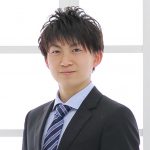Hometown in Japan: Chigasaki, Kanagawa
B3: Junior, Expected Graduation Date: March 2020
Host Professor: Dean Reginald DesRoches, School of Engineering and Prof. in the Depts. of Civil and Environmental Engineering and the Department of Mechanical Engineering
Recipient: 3rd Place Poster Presentation Prize Joint RCQM-Nakatani RIES Research Poster Symposium
Why Nakatani RIES?
The main reason why I applied to the Nakatani RIES program is that I am convinced it will expand my possibilities in the future. Although I have thought of going to graduate school abroad, I have not yet experienced the real research environment overseas. In the Nakatani RIES program, I believe I can experience how research is conducted in the U.S. and learn more about the relationship between students and professors in a U.S. research laboratory. I am really looking forward to interacting with people from various backgrounds and developing myself in challenging conditions. I am sure this program will be meaningful for doing research next year in Japan as a senior undergraduate and later on in my future career.
- To gain confidence in speaking and communicating in English
- To learn about the process of conducting research
- To experience a cutting-edge research environment
- To widen my future choices
Nakatani RIES Experience in the U.S.
I would like to give some advice to future participants in the Nakatani RIES Fellowship program. First, we can receive great support throughout the program. Therefore, you don’t need to worry about life in a foreign country even if you haven’t been abroad before. Furthermore, the students in the lab are always very kind to us. Those who participate in this program come from different universities in Japan, so we can also build friendships with other Japanese students. In conclusion, it should be better for you to apply for this program if you are interested in international experiences at all.
This was the first time for me to conduct research and study about earthquake engineering. I would like to continue working on this research remotely and evaluate our results more precisely and deeply. Hopefully, I want to write a paper and present it at an academic conference. I talked with my friends in my home university about this program. Every time I talked with them about this program, they said “If I had known about this program, I would have applied for it.”.
I guess that the person who is reading this article already has an interest in foreign countries. I feel that the number of students in Japan who truly know about graduate school in the U.S. is quite small. I believe that if more students go abroad and research overseas, the education level of the universities in Japan and the research activities will be more internationally active. In order to gain this knowledge, I think this program is the most appropriate opportunity. Therefore, I would like to spread the word about this program and make this program more effective.
- My favorite experience in the U.S. was … my farewell party on the final day in Houston. I loved all the students who supported me and I miss them.
- Before I left for U.S. I wish I had … searched the places to visit in advance. I still have still a lot things I want to do in Houston such as visiting Houston Museum of Natural Science. On the other hand, I wish I would have talked about the overall research internship with my mentor during the last week because he had to leave Houston in the evening of our last day when we did the poster presentation.
- While I was in the U.S. I wish I had … worked out more frequently. I did it about five days in a week but I wanted to do it every day.
Excerpts from Gen’s Weekly Reports
- Week 01: Arrival in the U.S.
- Week 02: Life in My Research Lab at Rice
- Week 03: Interview with U.S. Student and Researcher
- Week 04: Reflections on English Language & Life in the U.S.
- Week 05: Final Week at Rice and Research in the U.S. vs. Research in Japan
- Research Project Overview and Poster
- Week 06: Last Week in the U.S.
- Final Report
- Tips for Future Participants
Week 01: Arrival in the U.S.
I have been to Guam and Hawaii before, but this is the first time for me to travel to the mainland of the U.S.. Furthermore, I haven’t experienced such a long term stay abroad. Therefore, I didn’t know what to prepare beforehand. I did a lot of researched about the climate, food, and people in Houston and I even bought new, larger suitcase for this program. When I finished packing my luggage, I found that one side of my suitcase was empty. Then, I added disposable paper cups and chopsticks which only weigh a little. Even if you still have more room in your suitcase, please be careful to not to go overweight (in our case 23kg is a maximum).
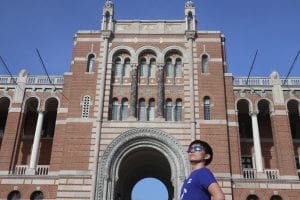
As I had expected, it was very hot and humid in Houston but freezing cold inside of the buildings. I hope I won’t get a cold during my stay. My first impression of Houston was that everything is very big. During the first week, I have been served large amounts of food I cannot eat many times. I couldn’t believe that anyone could eat it all, but I found that some people took the leftovers home. I thought that was a big cultural difference between Japan and the U.S. As for people in Houston, they are very friendly and talk to us even if we don’t know each other. What surprised me most was the behavior in the elevator. When I took an elevator in the hotel, I was spoken to by a couple and they asked me where I was from. I haven’t experienced this type of conversation in Japan. I wondered why they do so and I thought they just like to have a conversation. However, I was told by Sarah that it is true that they don’t hesitate to have a casual conversation with someone they don’t know, but there is another aspect. They have a conversation to make others feel relieved and think they are not dangerous.
I also noticed that there were very few bikes on the road. In the U.S., taking a right turn is allowed even if the traffic right is red. Also, there was no room to ride a bicycle on the edge of a road. I was told that biking in Houston can be dangerous, but I was convinced by seeing the situation of the roads myself.
I had a lot of orientation program activities at Rice University this week. All of them provided us very useful information were a lot of fun.
- Introduction to Life in the U.S.: I learned mainly about habits in the U.S. and what surprised me most was the tipping system. Although I knew there was a tipping system in the U.S., but I thought it was so strange that some types of workers make money only by tipping.(In Japan, we have minimum wage!)
- Introduction to Research in the U.S.: We have only five weeks in Houston, but we have no less than five weeks to learn a lot of things. Though I won’t be able to make an outstanding result, I will do my best and I want to learn how to perform research and what working in a lab in the U.S. is like.
- Intercultural Communication in the U.S.: There is a big difference between cultures and sometimes we may feel bad because we don’t know others habits. I found the concept of “ISH”, such as arriving at 5ish, in the U.S. to be interesting. I will remember this expression and I try not to be confused when somebody doesn’t come exactly on time. (In the first place, the concept of time is different.)
- Campus Tour: We walked around the campus of Rice university and I recognized that there is plenty of land and most of the building were so nice! I also saw lots of squirrels in the campus, they were so adorable!
- Tips on Using/Speaking in English: I realized that my English can became more natural after learning some tips on accents. I used these tips during the Welcome Lunch when I introduced my name right after I learned how to pronounce it to native English speakers.
- OISS Check-in and Visa Review: I realized that the J visa is very special type of visa and a lot of procedures are required for it. I am really grateful for all their support.
- Introduction to Designing a Research Poster: During this session, I go tot see a lot of kinds of posters, and I found that the quality is strongly influenced by the format when designing a research poster. Of course, the content is very important, but I will pay careful attention to the format as well.
We also went to grocery stores on Monday and Thursday. They were almost the same as those in Japan, but one difference was that most vegetables were sold in pounds. We were excited to walk around the stores and as a result, I spent over 100 dollars buying groceries this week.
During the mural tour on Saturday, I was surprised to know that some of the paintings on the wall is legal. They are one form of art. As for the Cistern tour, it was so beautiful inside that I couldn’t imagine it had been a working reservoir in the past. Overall, everything was fresh and stimulating!
Reflections on Intercultural Experiences
One week in the U.S. has already passed, and I have experienced many things that surprised me. I will talk about the topics focusing on people. I have been taught the difference in the way of thinking between Japan and the U.S. before I came to Houston, but some of what I learned were partly true and partly different too.
First, I was invited to several dinners this week and it was the first time for me to meet almost all of the guests. However, they positively spoke to me and asked me many questions. Because I was very nervous and I was anxious about how I should communicate with them, this made me feel so relieved. From this experience, I learned that people in Houston were eager to know about different culture and they valued diversity. Furthermore, when I met the people I haven’t known before, the first thing we did was to shake hands. Japanese people usually just greet and don’t shake hands in such a situation. I thought American people wanted to become friendly from the very beginning while Japanese people check someone carefully and hesitate to initiate physical contact at first. Therefore, I will make it a habit to take the initiative to shake hands when I meet someone for the first time.
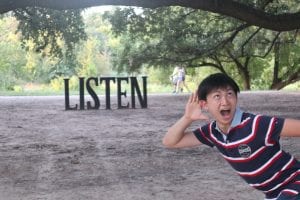
Second, I attended a lecture on the engineering of bridges this Tuesday because of a recommendation from a Ph.D. student from China in my lab. In general, it is said that Japanese students hesitate to raise their hands and ask questions while students in the U.S. are eager to do that. The content of the lecture doesn’t necessarily relate to what I am researching directly, but I am interested in the subject and wanted to see the difference in the behavior in a seminar between Japan and the U.S.. Actually, there were many differences to note. One of the differences was the listening behavior in the class. They listened to the lecture looking directly at the speaker. In Japan, most people sit far from where the speaker gives a lecture and concentrate on taking notes or even play games with their smartphones. On the other hand, students in the class were taking notes about only the important things and spent most of their time looking at teacher. In addition, no one was sleeping. Of course, the frequency of asking questions was far more in the U.S. compared to Japan. I thought that they value making their presence felt and that this also represents that the U.S. is the capitalist country. As for me, I usually hesitate to ask questions especially in front of many people and I found that I pay attention to take notes in detail rather than listening to the lecture. Therefore, I will try to ask questions more often and put more emphasis on listening.
Preparing for Research in the U.S.
Before my departure, my mentor sent me some textbooks and papers to read in advance. Because I haven’t learned a lot about this research topic before, I started to study from the entry-level. Though the host lab was decided one month before we departed Japan, I had examinations until the early August, so I couldn’t spare a lot of time to prepare. As a result, I studied all day long for several days before our departure. If I had the opportunity like this in the future, I would narrow down the range of fields the labs I want to apply for so that I can study before the host lab is decided.
Reading textbooks and papers that I hadn’t studied before was a lot of fun, but it was very challenging at the same time. This is because they were written in English, of course, and the technical terminology is even more difficult. Sometimes, I couldn’t even find these technical terms in a dictionary. In my case, I read textbooks in the same field that were written in Japanese beforehand so I could somewhat more easily understand the contents. I would recommend to do that if you are not confident in reading technical articles in English.
Initial Meeting and Days in the Lab
On Tuesday, August 14th, we had a welcome lunch and it was the first time for us to meet our mentors and the host professors. I was very nervous and I was thinking about what I should talk about with them and how I should have a conversation… However, when I met my mentor, I found that that kind of anxiety was totally a waste of time. They were really kind and friendly! After having lunch, I went to the the civil engineering building, Ryon Lab, where my lab is located. There was a lot huge equipment inside the building that we could see anywhere from the stairwell. As for my lab, it is a relatively small lab because my host professor, Prof. DesRoches, came to the Rice University last year from Georgia Tech and he is also Dean in the School of Engineering. There are three people in my lab, one post-doc from China, who is my mentor, one Ph.D. student from Iran, and one visiting Ph.D. student from China. Because I have been to Beijing about 7~8 years ago for sightseeing, I could talk with my mentor a lot about China. The people in the lab are also interested in Japan especially in Japanese food, movies and cartoon, so when I brought them some green tea and Japanese sweets to the lab as a souvenir, they were happy to try them. It made me happy and I recognized again that Japanese culture is very popular for foreign people just like I am interested in U.S. culture.
First, my mentor gave an overview of the research in the lab to me. He explained so politely that I could easily understand what I am going to do. He even made a word file which contains the background, importance, process, and the five-week plan of the research for me. I really appreciated that. Then, I asked him several questions about things that I couldn’t understand by reading the textbooks and papers that my mentor had recommended. Thanks to his explanation, these points of uncertainty were all clarified. The atmosphere in the lab is very comfortable for me. The A/C is not so strong that I don’t need to wear an overcoat. Also, the working time is very flexible and it almost depends on each individual. In the first week, what I had to do was become accustomed using a program that was written in Matlab. Because I haven’t used the computer a lot before, I had difficulty understanding what each statement represented. As time went by, I could gradually improve my skills. It is a lot of fun!
On Friday evening, my mentor invited me to a welcome party for new students. There were many graduate students. Even though I am a visiting student for just a month, they pleasantly welcomed me and I was very impressed. The food was very tasty and I had a lot of fun talking with many people. What surprised me was that almost half of the people there were from China and the rest were from India. There were only a few people who came from the other countries. I wondered why there is a situation like this?
Question of the Week
Why are there so many students from overseas in Rice university, especially from China and India?
- For more on this see the section on International Students in the U.S. on our Education in the U.S. page.
- You may also want to read Rice University’s OISS Annual Report which will tell you more about the international student population at Rice University.
- Another resource is the National Science Board’s 2018 Science & Engineering Indictors which gives a lot of data on students in the U.S. overall, including the numbers of international students studying in science and engineering. See Chapter 2 on Higher Education in the U.S.
Week 02: Life in My Research Lab at Rice
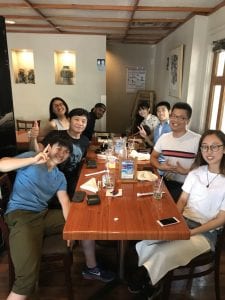
In my lab, other than me there are three group members. One of them is a post-doc from China ,who is also my mentor, a Ph.D. student from Iran and a Ph.D. student from China. Te Ph.D. student from China is now in her fourth year and she came to Rice University this past April. She spent three years as a Ph.D. student in China and she is now studying in Rice University. Soon after she goes back to China, she will have thesis defense. Through her experience, I realized that there are many different ways to study in the U.S. She is also researching the topic of bridge engineering, so I can discuss or ask her questions about what I learned in my bridge engineering class. This is a lot of fun!
I ask questions mainly to my mentor, but everyone in the lab pleasantly answers to my questions. I work in the lab most days from 9 a.m. to 6 p.m. and after that I usually go to the gym to work out, play badminton, ping-pong, squash etc. My mentor sometimes takes me to the gym and we play squash and badminton together. I really appreciate that because I can communicate with him more frequently and have conversations about topics we don’t talk about in the lab.
One of the routines in my lab is to go out for lunch together almost every day. Some people bring their own lunch boxes and others buy some food mainly in the student center. In this respect, I can know each lab member more deeply and I can practice talking in English. Furthermore, we spend time together even on weekends. We often play badminton and then go out to eat at a restaurant. This Sunday, we went to Houston Premium Outlet and had a a lot of fun. The lab I belong to is relatively small, so this is a very good point to have a close communication.
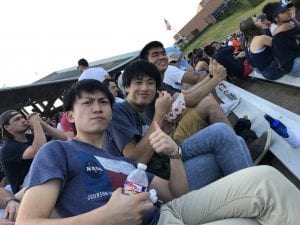
What surprised me about daily life is the thoughtfulness of each member in the lab. Since I am a visiting student, I am the youngest in the lab. However, when we go out for some purpose, the first member of the lab to leave the room will open the door and hold it open until all of us go through. I was so surprised and felt sorry for them at the same time. Even if they don’t think I am rude (I am sure they do this out of kindness), I thought I should pay attention to do that too. Since then, I make it a habit to go first and open the door as frequently as possible. Every time I do that they say thank you to me, which makes me happy.
The host professor of my lab, Prof. DesRoches, is also the Dean of the George R. Brown School of Engineering. Because he is very busy, he is rarely in the lab office and I haven’t met him yet. I would like to meet him and talk about research someday. We had some seminars and programs this week as well. Especially, my view about getting Ph.D. in the U.S. was significantly changed through these activities.
-
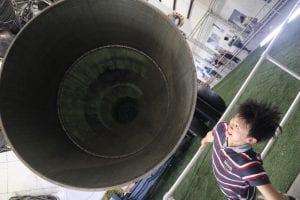
I was almost blown off by the engine of the rocket.(Actually there was no wind.) ~ Gen Hayakawa Lunchtime Panel Discussion “Graduate Study in the U.S.”: Before this seminar, I had just vague knowledge about the graduate school. However, I can now understand the importance and advantages of the Ph.D. in the U.S., how to apply for and what to prepare for the graduate school
- Lunch Session withProf. Matsuda, Dean of Graduate and Postdoctoral Studies: Because I haven’t thought deeply about the difference between being a scientist and engineer, his lecture was so fresh for me. Thanks to his lecture, I am no longer afraid of changing my major and my possibilities in life were expanded.
- Strategies for Vocabulary Acquisition (Kyung-Hae Bae): I learned that the attitude when we encounter words we haven’t known before is very important. Actually, I made some lists of words that I didn’t know starting from when I was a high school student, but I quit the habit after that. Now, I will start making words list again and try to pay attention to the unknown words from now on.
- Trip to NASA Johnson Space Center: This is one of the most exciting programs for me. I didn’t have much knowledge, but I was so surprised to see how big the ISS was and there were national frags in each component. I thought the dream to develop space is common all over the world. Furthermore, I was overwhelmed by the size of the rocket. I cannot imagine that such a huge rocket goes out of the earth.
Question of the Week
When I went to Houston Premium Outlet this Sunday with my lab members, I was asked what I wanted to buy frequently though I was just looking around. Is there any incentive for the staff if the costumers they talked to buy something? Or, is this just a culture here?
- This is the culture of good customer service in the U.S. You will not only be greeted when you first enter the store (like in Japan) but people will also come up and ask if they can help you find anything or if you are looking for something special. You can just say, “No thank you, I’m just browsing” and they will leave you alone. However, unlike in Japan, salesclerks are taught to engage with customers first rather than waiting for a customer to first ask for help.
- Sometimes, sales clerks do receive a commission on how much they sell so you may be asked when you check out “Was anyone helping you today?” If there was a sales clerk who did help you, try to give their name or describe what they looked like and then that sales clerk will get credit for the sale (a commission on the overall total) even though a different person ‘rung you up’ (was the cashier).
Research Project Overview
I am majoring in civil engineering and I am doing research in the Department of Civil and Environmental Engineering at Rice University. I am doing research related to earthquake engineering. In more detail, I am doing seismic assessment of a single degree of freedom (SDOF) bilinear system when we input pulse-type and earthquake motions. Naturally, structures have multi degree of freedom (MDOF) systems, but it is usually simplified to SDOF systems. By converting systems from MDOF to SDOF, we can analyze and tell the properties of the structures more easily. Especially for a first mode dominant system, this approximation would be more reasonable. On the other hand, we often have difficulties when there is nonlinearity in the systems (the relationship between displacement-force or velocity-force).
In this research, we will explore the seismic performance of the approximated nonlinear SDOF systems. As an approximated nonlinear systems, we use bilinear models first, and compare with the nonlinear systems. By doing so, we evaluate the effectiveness of using nonlinear viscous dampers to reduce the structural damages. Finally, fragility functions will be further investigated to take uncertainty of ground motion into consideration.
Research methods
- Understand the general properties of structures
- Simulate the seismic response of equivalent SDOF bilinear systems using
- Newmark-β method
- Newton-Raphson method
- ODE method
- Evaluate the effectiveness of viscous dampers to improve the seismic performance in the SDOF systems
- Investigate the fragility in the SDOF systems
Training: I have to acquire the basic use of Matlab before doing research, but I don’t have any equipment to require additional training so far.
Timeline
- First and Second Week:Understand and carry out the numerical modeling schemes with Matlab for SDOF systems with and without viscous dampers. Interpret the seismic response of the SDOF system when subject to pulse motion.
- Third week: Interpret the seismic response of the SDOF system when subject to realistic ground motions and evaluate the effectiveness of the damper.
- Fourth and Last week: Develop fragility function and make the poster.
Week 03: Interview with a U.S. Student and Researcher
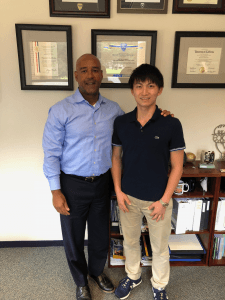
I interviewed Professor Reginald DesRoches who is the William and Stephanie Sick Dean of the George. R. Brown School of Engineering and also a professor in the Department of Civil and Environmental Engineering and the Department of Mechanical Engineering. He was born in Haiti and grew up in New York. He entered the University of California, Berkeley and earned a Bachelor’s of Science in Mechanical Engineering, then a Master’s of Science in Civil Engineering and finally a Ph.D. in Structural Engineering. Soon after earning his Ph.D., he became an Assistant Professor at the Georgia Institute of Technology and he has received numerous awards. One of them is the Presidential Early Career Award for Scientists and Engineers, which is the highest award given to the researchers in their early careers. He became a Full Professor in 2008 and then he was named the Karen and John Hoff School Chair and Professor of Civil and Environmental Engineering at Georgia Tech. He came to Rice as Dean in July 2017. He has been invited to many universities to give lectures. In addition, he plays an important role in the American Society of Civil Engineers and the National Construction Safety Team (NCST) Advisory Committee. I was very surprised to see that he is active in a broad variety of areas.
His research focuses on earthquake engineering and development of innovative protective devices for structure resilient to earthquake. In more detail, he is investigating Shape Memory Alloys (SMA). This is an alloy that remembers its original shape and when it is heated, it becomes the same shape as before. One of the most notable properties is its superelasticity. Things which have superelasticity can return to its original shape after the removal of even relatively high loads. In general, deformation remains in things more or less after the removal of the loads. Because SMA has the property of superelasticity, little deformation remains. Furthermore, it has bigger damping ratio than ordinary damper. As a result, energy dissipation gets bigger and highly reduce the displacement and residual.
As I mentioned above, he changed his major from mechanical engineering to civil engineering and then structural engineering. Therefore, I wondered how difficult to change majors. He thinks that changing majors is difficult in general. However, the fields he has experience in were closely related to each other and they have basic backgrounds in common. As a result, it was relatively easy to change majors for him. I thought changing majors was challenging but this broadens my horizons.
He is Dean of Engineering at Rice University and he has also served as a department chair in many places. I have had some opportunities to be a leader, but every time I became a leader, I had difficulties giving others motivation. Therefore, I was curious about what he thinks the important things are to be a leader. He gave me three things to be a good leader. First, having leadership experiences helps to become a good leader. Second, a leader has to know people well such as how to work with people and how to deal with challenging issues. Finally, to know how to talk and have constant communication with people working together is important. I had a lot of things to learn about, not only the content but also his style of speaking such as his tone of the voice, the intonation, the pronunciation, and the facial expressions.
He is a Dean but he is a researcher at the same time. If I were in his position, I would not be able to make it because of too many things to do. Then, I asked him how he dealt with this busy schedule. He told me that the schedule should be well organized or he sometimes has to put long hours to work. He also advised me to have good people around me. They can help me when I am in trouble and he thinks this is the most important thing. I strongly agree with his opinion and I will try to make good relationship with my friends.
Then, I asked him the important things for researchers. He thinks that having good technical background is very important and computational techniques are needed as well. Also, he said that good writing skills help us to be good researchers because we will write several papers as a thesis. The other thing he mentioned was asking questions. He told me that it is important for us to think carefully and ask good questions. As I was told in the seminar of this program, that the students who ask question will be well appreciated, I again realized the importance of asking questions.
I am very interested in earthquake engineering, which is popular in Japan, but I would like to study in the U.S. at the same time. Therefore, I asked what he thinks the advantage of studying in the U.S. and Japan in the field of earthquake engineering. He said that the environment is similar but Japan has more facilities and institutions and because of that there is more research using these facilities. On the other hand, the U.S. focuses on theoretical research in this area.
Finally, I asked a question about the lecture he gave last Friday. I thought SMA has a bigger damping coefficient than ordinary damper, which means that a large amount of dissipated energy should be converted to another form like thermal energy. Therefore, I wondered if there were challenges related to thermal energy. He told me that the properties of SMA changes if the temperature changes. Of course superelasticity does not always exist. Therefore, he is thinking about the way to release the thermal energy.
It was a 10-minute short interview but I had a very good time to talk with Professor DesRoches. Even though he is a very busy man, he usually works out six times a week, running outside three times a week, and biking inside once a week. I don’t think I can become a man like him but I strongly think that time management is really important. I will try hard to make my schedule well organized gradually. I was so nervous during this interview that I could not speak English well. I wanted to make it more interactive but I couldn’t. I regret that. During the interview, I was impressed by his personality. He is very kind and he listened to what I was saying carefully even when I was at a loss for words. If I have an opportunity to be a leader, I want to be one who can take care of other people and can make others motivated like him.
Interview with Student
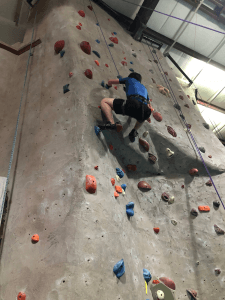
I also interviewed Jayant Patil who is a second year Ph.D. student in the Department of Civil and Environmental Engineering. He was born in India and he got his Bachelor’s of Science and Master’s of Science in his home country. Then, he came to the Rice University to pursue his Ph.D. His research interest is in structural design.
He was thinking of going into academia after getting Ph.D. when he came to the U.S. On the other hand, he thinks this path would be very hard because there is severe competition at this time. If he goes into industry after graduation, he wants to do work which is related to his current research, reliability analysis. He worked in industry for a time after his graduation from his Master’s program. There, he thought performance based design is very interesting. Also, he was interested in computational analysis. This is the reason why he got interested in this field.
I asked about the application process for graduate school in the U.S.. He advised me that sending emails to professors whose research is interesting for me is important. He applied to seven universities and he told me that the best strategy was to apply to two universities in the top level, three universities which I can have good chance, and two universities which I am almost sure to pass. His suggestion changed my way of thinking about my career. I have thought that getting Ph.D. right after getting a Bachelor’s degree is the best way. However, he suggested that I should get Master’s degree or do a job before the application for a Ph.D. because we cannot get enough knowledge as an undergraduate. He thought getting experience is a bigger advantage than the disadvantage of taking two extra years.
Finally, I asked the reason why he decided to come to the U.S.. He said the educational system of the top universities in India is based on that of the U.S. Also, he also thought that the level of the U.S. universities was high. To my surprise, he said one of the factors was that his close friend lives here.
I was impressed by his enthusiasm for studying. He was the best student at his university in India and he spontaneously started to read papers. I thought that students in other countries seemed to study much harder than those in Japan. I heard that the ranking of Japanese universities is declining, I am sorry but I thought I have to admit the situation.
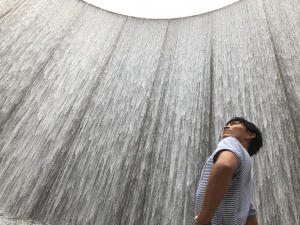
Reflections on the Interviews
The first impression was that conducting these interviews was very difficult. I prepared for several hours, but was still not satisfied. One of the main reasons was lack of the ability to listen to what others are saying. I couldn’t catch everything so I couldn’t ask additional questions so much. That is also one of the reasons I couldn’t make the interview interactive.
I thought the interview was such an effective wsa to learn about the person deeply and efficiently. As I mentioned before, I could learn his perspective and his character as well. I asked mainly general questions this time. I am very curious about their research. I would like to ask how to conduct the research and how to organize the time schedule if I have another opportunity.
Reflections on Seminars & Other Activities
- Webinar on Career Decision Making (Jen Topp, Lehigh University): Until this seminar, I had thought that elevator pitch was mostly used for those who want to be an entrepreneur to introduce their business idea. I learned that we can also use it when we attend a conference where many researchers gather. I will practice it a lot and make use of such opportunities.
- English Idioms Commonly Used in Academia (Dr. Jennifer Shade Wilson): I have learned English for many years and I know some English idioms. However, I don’t know the meaning behind the words, or the nuances so much. This lecture was so meaningful for me to understand the importance of it especially in academia. I will pay attention to it in the poster presentation too.
Research Project Update
I almost finished the research itself last week so I started to make my poster from Wednesday. I had a meeting with my mentor and confirmed my understanding of the research so far. Thanks to this meeting, I could understand the flow of the research more clearly.
Because this is the first time to make this kind of research poster, I first read some books and websites that helped me to understand how I make it. I also checked the slides provided by Dr. Gayle Moran again. In some materials, it is said that we should aim for 40% graphic to show visually what was done. Therefore, I added some graphs and make it more attractive. One of the most challenging things in making a poster was the layout of the poster. I learned that it is not desirable for each section to spread out over two columns. However, I had difficulty deciding the position of the methods section because of this restriction. I think one of the most important parts is the introduction section, so I tried hard to make it easy to understand the overview of the research for those who is not in the field of earthquake engineering. To do that I put some pictures and figures.
When I made the methods section, I faced another problem which was a struggle for me. In my research, I used many equations, but it will be hard to understand if I just list these equations. Therefore, I made an effort to make a clear the flow of the analysis using some graphs and arrow symbols. To make the first impression of the poster better, I thought graphs play an important role. I heard that it should be readable from 10 feet ( 3meters) away. I took care of the style of the graphs (such as the width of the line and the font size of each letter etc…).
I will have more opportunities to write a paper and make poster in the future. This time I could learn a lot about how to make poster and I had a precious experience with other undergraduate students. I found it a lot of fun, because, to make a poster, I should understand the research in more detail and I could recognize the parts I didn’t understand completely while I was making it. It also helped me to sort out my thoughts. I want to enjoy poster session! Therefore I will do my best preparing for it.
Week 04: Reflections on English Language & Life in the U.S.
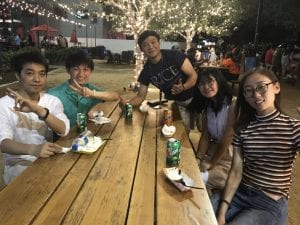
Three weeks have passed since we came to the U.S., and I hope my English skills have more or less improved. In my lab, all of the students are not native speakers of English. Therefore, they don’t speak so fast that I couldn’t catch what they are saying. On the other hand, because their intonation and accents are a little different, I found it difficult to listen at first. Because I had a lot of opportunities to speak with them, I could understand their accents gradually. My lab members also asked me many questions about Japan. In this situation, I needed to explain the words they didn’t know using easy words in English. I am not very good at doing this but they were good opportunities for me to practice explaining the unknown words with known words. As I mentioned before, because their native language is not English, they sometimes have difficulties telling something in English too. In this situation, I sometimes was able to explain what they want to say. I believe these experiences helped me explain the technical terms clearly to those who in the different fields at poster presentation.
Since Houston is very close to Mexico, there are many Hispanic people who live here. Their English is a little difficult to understand, but I have a lot of fun speaking with them. In particular, when I was having a breakfast at the restaurant of the hotel, I found they were speaking Spanish as a tool of conversation. Because I learned a little Spanish when I was a high school student, I was able to chat with them a bit in Spanish. I am not very good at speaking Spanish, but a little knowledge about the language was enough to make conversation better.
As for my English, I often had difficulties explaining what I wanted to say. Therefore, I tried to find the cause of these difficulties. I found that I couldn’t concentrate on making sentences because I didn’t have a large enough vocabulary. If I can find the proper words more easily, I will be able to focus on making sentences and speak more fluently. One of the most important things I thought to improve my speaking skills was not to think about what I want to say in Japanese first. This is because when I try to translate Japanese sentences into English, there are some difficult word to explain in English. Therefore, I’m trying to make it a rule to think in Japanese as little as possible.
I also feel that gestures are useful and strong tools to be able to communicate with someone when we don’t have an understandable language in common. Furthermore, I found that even when we can communicate with the same language, using gestures enables us to have a conversation more smoothly and prevent misunderstanding. Most people I met in the U.S. are interested in Japanese culture and I was asked questions frequently about my culture and society once they found out I was from Japan. In this respect, I need to have the knowledge about Japanese culture to some extent especially about anime, manga, movies, and dramas.
Of course, I studied English for the entrance examination of the universities, however, the English I learned at that time and what is actually used in daily conversation in the U.S. is different. I think the best way to acquire true spoken English conversational skills is to speak in English as much as possible. Therefore, I tried hard to find the opportunities to speak in English during this program. Because I was not confident in my English skills, I found communication through sports was a very good way to become more accustomed to speaking English.
I had many kinds of seminar activities especially about graduate school this week.
- Career and Research Journey: From Industry to Academia (Prof. Akane Sano, Dept. of Electrical & Computer Engineering): I learned that there are many ways to build a research career and we can flexibly change the job if we have enthusiasm to do that. I want to find the thing I can devote myself and I will take good care of the relationships with people I have met.
- Introduction to Houston: Diversity, Urban Issues, and a City for the Future (William Fulton, Kinder Institute for Urban Research): The geological and historical background of Houston is totally different from other cities. To adjust to that condition, I thought the infrastructure in Houston should be changed especially in terms of flooding.
- Academic Style Writing – Preparing for Graduate School (Kyung-Hee Bae, Center for Academic and Professional Writing): Because the document itself is not so long, making it attractive is very difficult. Before application, I thought I should practice many times and acquire the manner to write that.
-
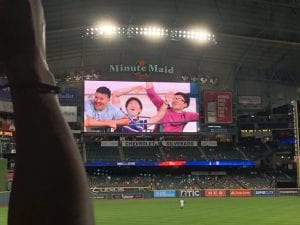
Katsuya and I were projected to the big screen! ~ Gen Hayakawa Watching baseball games (vs. Anaheim Angels): I was excited to see Ohtani play on the field! I was not sure which team to support but I felt I was happy that Angels won the match. This was the first time to watch a baseball games in the stadium and it was a lot of fun!
- The U.S.-Japan Relationship Through Baseball (Prof. Sayuri Shimizu-Guthrie, Dept. of History): I haven’t thought about the relationship between baseball and the history with U.S. before, but I could easily see the relationship and understand the history more deeply as well.
- Lecture by Professor Reginald DesRoches: This Friday, I went to a lecture by Prof. DesRoches, my host professor. His research topic is very interesting of course and I was highly impressed by the delivery of his presentation in particular including the tone of the voice, pauses, jokes and the response to the questions. I will keep in mind to what I learned here in the poster presentation.
Research Project Update
Before analyzing the response to the real earthquake motion, I started with the response to the pulse-type motion. Pulse-type motion is a motion which has a sin/cos curve and only one cycle. After one cycle, the motion stops and the vibration of structure starts attenuating. For each analysis, I have damper and non-damper systems. Damper is a device that has a resisting power that reduces the displacement and acceleration of the structure, which decreases the damage to the structure as a result. Furthermore, for each system we used two way to solve the problem. One is the ODE method. Matlab originally has many kinds of solvers for differential equations. Among them I used ODE45 because it enables us to solve at the high accuracy. Another one is using the discrete equation. In more detail, first we use Taylor expansion and derivate the relationship between the current state variables(acceleration, velocity and displacement) and previous state variables. Then, we arrange the equation so that we can easily calculate and easily understand what we are doing. However, these equations are implicit so we have to iterate again and again until the solution meets the convergence conditions. Implicit equations means we cannot calculate next timestep variables only with current variables. The method we used is called Newmark-βmethod. As the way to do iteration, we used the Newton-Raphson iteration method. It is also using the Taylor expansion and omit the negligible value. Since we made a change to the original value, there should be some error. Therefore, we calculate the equation which was made before again and again and continue calculating until the error fall below the certain value.
We could calculate the response of the bilinear system without dampers when subject to pulse-type motion, but we couldn’t get the appropriate solution regarding the damper including the system. My mentor and I checked the code several times but we couldn’t find the mistake at that time. Therefore, we decided to focus on ODE method first and then change the focus to bilinear model if we have time. As for ODE method, we used the differential equation called Bouc-Wen model. I made the codes to calculate the equations and run it in two cases (with damper case and without damper case) with pulse-type motion as an input. In these cases, we could see the effect that damper reduced the displacement.
On Thursday, we started to input 320 different kinds of real ground motions. It took a lot of time to analyze all of them. Every time I checked the results, I got nervous because it would take another hour to run the code again if it fails. For this process, it seemed to work well and we moved on to the final phase. On Friday, I set about making fragility function. Fragility function is a function that indicates the relationship between probability of getting certain damage and peak interstory drift ratio/residual interstory drift ratio/peak floor acceleration. I input the 320 types of ground motion to the two models (with damper and without damper) and recorded the three values above. And then I conducted the linear regression analysis to the derived solution and used the normal cumulative distribution function to make the fragility functions. However, we had difficulties getting the reasonable results this time as well. We also ascertained the code but there was no fatal mistake. Thus, we investigated the result carefully and found that there may be some convergence issue. We changed the ODE solver and finally got the reasonable results on Sunday evening.
Week 05: Final Week at Rice and Research in the U.S. vs. Research in Japan
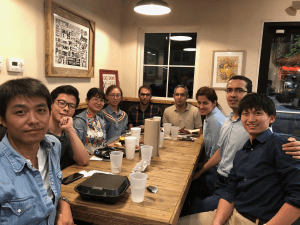
In my final week in the lab, I focused on the poster presentation because my research had been already been completed. On Monday, I had to submit the first draft of the poster, and I put an emphasis on the structure and the design of the poster. In the afternoon, we had a seminar about the poster presentation. We learned more deeply about how to do presentation such as useful expressions in the presentation and the structure of the presentation and the concepts of the three levels of audiences. What made me puzzled was the elevator pitch of the poster presentation. I was told to make the pitch of 90 seconds, but it is too short to explain the research I have done. At first, I wondered what I could do in such a short time, but gradually I understood the meaning of the short length. In my opinion, the most important thing in making elevator pitch is to make audience understand the big picture, the meaning and the results of the research clearly. Especially in the poster session this time, it was inferred that most people who came to it were majoring different fields so we would be presenting to an interdisciplinary audience. Thus, I tried to make my pitch more easily understandable. I presented my pitch to my mentor several times and I made some changes every time and I could make the pitch I was satisfied with.
As for poster, I had more difficulties than I had expected. I finished making the first version on Monday afternoon and I asked my mentor to check it. I thought the structure was not so bad, but my mentor told me to make some big changes. He advised me to change from 3 column to a 2 column layout. Although I didn’t have to change the content itself significantly, it was a very challenging task for me. I worked on this until midnight that day in the lab. On Tuesday, I showed my revised version of my poster and he praised my work. I was very glad to hear that. On the other hand, I was told that it contained too many words. Because I was taught that the desirable number of words was 650~700 in the seminar I took (maybe), this advice was surprising for me. But his explanation was also reasonable. Therefore, I decided to lessen the words and put additional graphs which describes my research visually. Interestingly, “Less words, more graphs” became the favorite phrases of me and my mentor.
The part I put biggest effort on was methods part. I used many models which could be described by equations. However, just listing equations would be annoying and unattractive to the audience members. Therefore, I attempted to make these equations visually understood as much as possible. In addition, I made the flow of the research understood at a glance. In this way, I made changes again and again and the final version of my poster was the seventh version. It was very hard but a lot of fun. I really appreciated my mentor’s help. He said that how much he supported was proportional to how much effort I put in. I was very happy to hear that.
On the final day of my stay in Houston, my lab members held a farewell party for me. Even though we came up with it on the previous day, eight people came. Unfortunately, my mentor had to leave Houston that night, so he couldn’t come to the party. However, they praised my efforts for the poster presentation and I enjoyed talking with everyone. I was so impressed by their kindness
Research in the U.S.: Expectations vs. Reality
At first, I was anxious about communicating with the people in my lab, and I expected that the research work would harder rather than being very enjoyable. However, it was much more joyful than I had expected. One of the main reasons for this was the kindness of the people around me. I belonged to the Department of Civil and Environmental Engineering at Rice, and I was so surprised that the interaction between different labs was so active. I took part in a welcome party for first-year Ph.D. students during my first week at Rice, and I was able to make friends with many students in the same department; even though we were from different labs. This was the first opportunity to have interaction with them. Since then, I played badminton, squash and ping-pong with them every weekend and also went out together for lunch.
I also sat in on three classes and this experience enriched my lab life as well. I could learn more about the atmosphere of the classrooms in the U.S. too. Of course the contents of the classes were also very attractive for me. Now, I don’t hesitate to ask questions anymore. I noticed another big difference between Japan and the U.S. from attending these classes. There was a long line waiting to ask the professor questions after each class. In Japan, we don’t do that so often and, at most, there are only a couple of students in line. The long line doesn’t necessarily lead to a good educational environment, but I am sure that students in the U.S. are more eager to ask questions about what they didn’t understand.
- Also, professors in the U.S. typically have ‘office hours’ each week which are posted in the class syllabus. These are ‘open door’ hours where professors are working in the office and students can stop by and ask for help or question. Students are also encouraged to make appointments to meet with professors or teaching assistances one-on-one to ask questions or ask for help and indeed, the best students in class are usually the ones who ask the most – not the fewest questions or for help with them need it. Asking questions and attending office hours also helps the professor get to know the individual students in their class and can be helpful in case you need to ask that professor to write a letter of recommendation for you as then they know who you are, not just that you were enrolled in the class and got ‘X’ grade.
In my lab, there was no hierarchy and we didn’t have any fixed time to come and leave the office. Therefore, I could work flexibly and I didn’t feel frustration at all with my schedule. We usually come to the lab at 9 a.m. and leave at 6 p.m.. As I mentioned before, the people in the lab had a very good relationship, so we had lunch together almost every day. My mentor encouraged others in the lab to go out for lunch. I was a little surprised to see everyone took a nap for about half an hour after having lunch. On weekends, I spent most of my time with the lab mates. I was very surprised that every time I went to the lab on weekends, there was always someone working in the lab. I heard that graduate students can have a holiday on the weekends but can also work even on weekends if we would like and I thought this was true.
On the other hand, I also felt that the school life could be monotonous. Therefore, I thought it was important to have many kinds of hobbies and have a good relationship with the lab mates and other friends to have a balance between working/doing research and your everyday life. On Tuesdays and Thursdays during my time at Rice, I took part in the soccer club. Most of the people in this club belonged to the department of Civil and Environmental Engineering. I thought the relationship in the department was very tight and I would like to choose a graduate university which has such a department in the future. It was a lot of fun! I was impressed by the power of sports. As I learned before, a popular question to ask someone we haven’t met before was about sports. Having favorite sports and teams is common in the U.S. and helped made us have a better relationship easily. In fact, I could make friends through playing soccer, badminton and squash.
One day, everyone in the lab, including me, attended a special lecture by Professor DesRoches, who is my host professor and also the Dean of Engineering at Rice University. In that lecture, many students asked questions to him. After that, we went back to the lab. I was amazed that they started to discuss the questions people had asked again. I had never experienced that kind of discussion. I recognized again that the core part of their learning was discussion and this helped them understand more deeply. I will try to discuss more often in Japan.
The life in the lab in the U.S. was totally different from what I had expected especially in terms of the human relationships. Because I haven’t experienced doing research in Japan yet, I cannot decide which environment is better. However, I loved the lab I belonged to at Rice and had a great time there. Furthermore, we had a lot of seminars that gave us detailed information about graduate school in the U.S. during this program. To be honest, I hadn’t thought of going to graduate school to get a Ph.D. in the U.S. so much. However, thanks to these seminars and experiences in this program, now I can imagine the possible career I will take.
We experienced five-week research internship at Rice University and it may be relatively short period in terms of doing research. However, I could make many good friends. Even though I spent just a month, they kindly talked to me and took me many places. In particular, the lab mates treated me as a family member. I will miss them so much. If there is an opportunity to go to Rice again, I strongly hope to meet them. This was an irreplaceable and precious memory for me. On the other hand, because this was the first time for me to go abroad for such a long time, I sometimes missed my home country. What I missed the most was the food in Japan. I guess almost all participants agree with this. I want to have grilled fish at first when I come back to Japan.
We had a several seminars and tours in our final week in Houston.
- Seminar on Poster Presentation & Small-Group Coaching Session: The previous seminar Dr. Moran gave us was focused on how to make a poster, but this seminar was about the presentation of our research. I thought it was very difficult for me to explain what I have done in just 90 seconds. Also, I recognized the importance of making eye contact with the audiences.
- Tour & Introduction to the TMC Innovation Institute: I was so impressed by the comprehensiveness of the Medical Center. It not only has many hospitals and research institutes but also encourages young people who have a good idea to be an entrepreneur.
Looking back, I did many things in this program and this was the best summer vacation I have ever had. It was a very challenging environment but it was a lot of fun! I was glad to share what we have done and what we have learned.
Research Project Overview and Poster
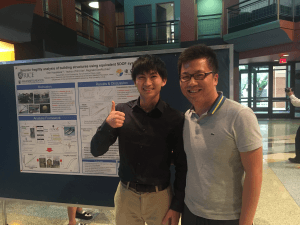
For the actual presentation, I was nervous about speaking in English especially without a prepared speech. Therefore, in addition to elevator pitch, I made a list of possible questions and considered some of the answers beforehand. I practiced elevator pitch again and again. This was the first time for me to make a poster and have a poster presentation. Therefore, I had no idea what I should prepare for it. I was told that the poster session would be a lot of fun but I didn’t believe that. At first, I thought 90 minutes was very long, but I felt it was actually much more shorter than I had expected. Many people in the same department came to see my poster, which made me relieved. In this session, because most of the audience knew the concept of this session, they allowed me to give the pitch I prepared. However, I heard that I usually have to deal with more people at the same time in a more chaotic situation. Therefore, I felt that I need to have more opportunities to speak English. I am sure this 90 minutes was the most intensive period I spoke English in my whole life. Finally, I was very glad to receive the 3rd place prize for the poster presentation. I could have confidence in myself through this experience.
Research Project Poster (PDF): “Seismic fragility analysis of building structures using equivalent SDOF systemsHost Lab”
Recipient: 3rd Place Poster Presentation Prize Joint RCQM-Nakatani RIES Research Poster Symposium
Host Lab at Rice University: Natural Hazards Mitigation Research Group
Host Professor: Dean Reginald DesRoches, School of Engineering and Prof. in the Depts. of Civil and Environmental Engineering and the Department of Mechanical Engineering
Mentor: Dr. Yazhou (Tim) Xie
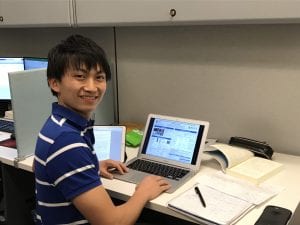
Introduction: Earthquake is one of the most tragic natural disasters and it causes great loss of life and properties. Therefore, there is a great demand to investigate the way to make building resilient for earthquake, and this is our big goal at the same time. In this research, we focused on innovative protective device, damper. Our specific objective was to improve seismic response using damper and conduct probabilistic assessment of seismic response.
Approach: We used Matlab in this research. Firstly, we simplified the structure of the building from multi-degree-of-freedom (MDOF) systems to single-degree-of-freedom (SDOF) systems. For damper and column, which are very important and determine the response of the system, we used some models which can describe their unique properties. For column, we used two types of models, one is Bilinear model with Newmark- method and Newton-Raphson iteration, the other is Bouc-Wen model with ODE method. To this system, we input 320 types of real earthquake ground motions and then we processed the data, made probabilistic seismic demand model (PSDM), and finally conducted probabilistic analysis using fragility functions.
Results: For deterministic time history analysis, constant results were obtained by two different methods (Bilinear model with Newmark- method and Newton-Raphson iteration and Bouc-Wen model with ODE method). We also recognized the considerable permanent deformation under pulse-type motions. From PSDM, we found that there was a significant difference between the system with damper and without damper. In addition, Residual drift ratio yielded large standard deviation compared to other two factors (Peak drift ratio, Peak acceleration). Finally, considering the fragility functions, damper seemed to reduce the displacement and residual. However, it doesn’t always contribute to the reduction of the acceleration. If the ground acceleration gets bigger, damper has even adverse effect on the structure.
Discussion: Damper can significantly reduce the structural and permanent damage of the building. On the other hand, damper is effective on reducing non-structural damage with small ground motions, but it has adverse effect when subject to large ground motions.
Conclusion: Optimal design of viscous dampers is required to reduce structural and non-structural damages simultaneously, which would improve the seismic resilience of the built environment.
Future Research: In this research, we simplified the structure of the building. Therefore, we have to validate the equivalent SDOF system by comparing to MDOF structures. In addition, further research is required to identify the optimal design parameters of dampers. If we can identify it, the next step is to make real dampers which has the optimal parameters. We also want to examine the seismic response with the system which is attached shape memory alloy (SMA) dampers, which has the property of superelasticity.
Week 06: Last Week in the U.S.
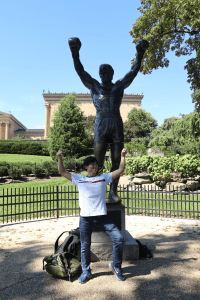
After staying in Houston, we left for Philadelphia on Saturday morning. In Philadelphia, we went sightseeing and what I enjoyed the most was visiting the Eastern State Penitentiary Historic Site. A penitentiary is similar to prison or jail, but it is said that the characteristic of penitentiary is the prisoners there have usually committed more serious crimes. This penitentiary isn’t used now, but most of the building remains the same way it looked when it was in use in the past. Therefore, we could imagine the life of prisoners, which was interesting to me. Though I had only negative image of prison before I visited there, there was enough room for exercise outside and desks for reading books. I found that those who are in prison were still ensured to live like ordinary human beings to some extent. On the other hand, as for the individual rooms, there were no windows. Thus, there was little light from outside and I was given a dark impression. I also went to the Philadelphia Museum of Art as well. It was so huge that I couldn’t see all of the artwork in just a day. There were many European works and I loved them. It also had a section of Japanese tradition which was focusing on Japanese teahouse. I was glad to see how foreign people regard the Japanese culture. The program gave us Big Bus tour tickets for the day so it was easy to get to the Penitentiary and Museum. A few of us were also planning to go to go on our own to the University of Pennsylvania and walk around the campus. However, we had a car accident on our way there. We were using Uber to get there. Suddenly, the car on the opposite lane intruded our lane. Our driver made all efforts to escape from the car, but we crashed into the car. Fortunately, we didn’t have serious damage. We got the precious lessons from this accident. Now that Uber is very convenient especially in the U.S., but the people in the U.S. usually drives more roughly than Japan. Therefore, we have to keep in mind that there is still a risk to have an accident while using this kind of service and it is important to always use seat belts when driving in any car in the U.S.; whether that is a private car, taxi, or Uber/Lyft.

On Monday, we visited Lehigh University. There, we discussed the results of the Strengthsfinders. Strengthsfinder is an assessment of our five major strength points based on over a hundred of questions. As for my assessment, the restorative ability was ranked first. This ability is similar to the ability to devise solutions to the problems and solve them. I was glad to see this result because I love challenging situations and I have always confronted challenging issues as a result. I hope this attitude leads to a good result. Some of my other strengths were includer, communication, individualization and learner. In this assessment, 34 types of strength are categorized to 4 big areas. My five strengths were spread over all of the areas. I was happy to see these results because I found that I had a wide range of abilities. On the other hand, it meant that I didn’t have any specific ability on one category at the same time, which could also be a bit of a disadvantage. However, I see my results as an advantage rather than a disadvantage.
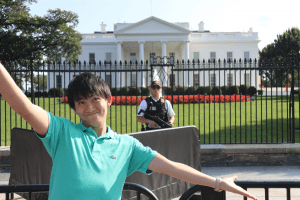
Among several activities at Lehigh University, what I enjoyed most was the lunch discussion with faculty. I talked mainly with Prof. Ethan Yang, who is an assistant professor in the department of Civil and Environmental Engineering. His research focuses on water issues. He told me that he had visited my home university and had meetings with a professor there. What surprised me most was that the professor he talked with was in our department and I have taken his lecture before. I thought the relationship among professors was very important. I also felt that the world of professor was very small. I was also surprised to learn that asking professors whether or not they can accept new students or how much they have money was natural. Originally I had thought it was rude but he told me it wasn’t and it was a very important question to ask when decide the lab.
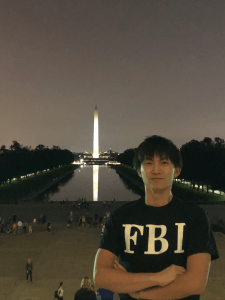
We then moved to Washington D.C. and I found there were too many places to visit in a couple of days. We had several program activities in Washington D.C., and what I enjoyed most was the Library of Congress tour. This library has largest number of books in the world, 31 million books! I was so surprised to know that. Furthermore, it has so many materials other than books such as art or newspapers, which amounts to 150 million. Even now, 10,000 new materials are added to their collection every day. Of course this library has an aspect of library, but it also has an aspect of a museum as well. There were many paintings on the walls and ceilings, and they were designed to express the essence of humanity, study, and the arts. I regret that I didn’t go back during my free time to make and I.D. card for the Library of Congress. I will be sure to make it when I visit D.C. next time.
Lastly, I would like to comment on my initial feelings when I went back to Japan. Because I was busy doing research and working out, I felt that time flew so fast in the U.S. However, I realized that I did many things in such a short period when I was looking back at the photos of this program. I really enjoyed my interactions with many people in the U.S., so I will miss them. But I was also looking forward to eating Japanese food at the same time. Therefore, six weeks are appropriate for my first long trip abroad.
Final Report
First of all, one of the most important things I learned in this program is about the research environment of the U.S. universities. I think that this opportunity is the biggest thing that makes Nakatani RIES different from other programs. In such a short period program (like a couple of months), we generally just have opportunities to go to foreign universities and just take classes. On the other hand, in this program, we are able to conduct a research project in a lab as well. By doing research in the lab, we can communicate with other students who are seeking a Ph.D. and network with professors. I feel most Japanese students don’t think of getting Ph.D. abroad and the main reason why they don’t is that they don’t know much about it. I was like this before I participated in this program. During Nakatani RIES I had a lot of opportunities to talk with Ph.D. students from foreign universities and I learned many things about graduate school in the U.S., which broadened my horizons.
I would say that the major concern Japanese students have about foreign graduate schools is financial aspect. True, the tuition of the U.S. universities is much higher than that of the universities in Japan. However, for students who are going to get doctoral degree, the professor pay the tuition on behalf of them if they hire you on as a research assistant. Furthermore, if you are hired as a research assistant you also get paid for living costs. Therefore, we don’t have to worry about the financial issue so seriously.
At the beginning, I was anxious about how to communicate with people. However, I got acquainted with almost everyone in the department of Civil Engineering by the end of the program. They even hold farewell party for me on the last night in Houston. This experience made me confident in my ability to communicate with people from various backgrounds. I would like to share that there are two important things to have good relationship with them. First, we should approach all opportunities to talk in English in a positive way. Frequent talking helps us understand their ways of thinking better. However, it is sometimes difficult to start a conversation. I would like to suggest that one of the easiest and most effective way is participating sports or club activities. When we are just talking, we don’t like silence in general. Therefore, we sometimes hesitate to talk to others for fear of it. However, we don’t have to talk all the time when we are playing sports together. Actually, I played badminton with my lab members, which greatly helped me to have conversations with them. In this program, even though five-week research experience is not so long, I have done many things in a brand new environment. My English is still poor, but I found I could make a good relationship with the people from all over the world. This is the most important thing I could learn.
Before I participated in this program, I didn’t have good lifestyle habits. I sometimes stayed up late and the time I got up varied from day to day. However, during my life in Houston, I had a fixed the time to start researching. Furthermore, I made it a rule to go to the gym on a daily basis. As a result, my lifestyle habit was greatly improved. Even after I came back to Japan, I wake up and go to bed at almost the same time every day. Thanks to this good habit, I am able to concentrate on my lectures better than before. There were more benefits I could get from good lifestyle habits than I had expected.
Tips for Future Participants
As for the preparation before departure, the first problem you may have is about packing. I guess you will prepare a big suitcase and you may put almost everything you need in your suitcase. However, there is a weight limitation. In our case, we could leave two pieces of luggage (each one should be under 23kg).
At Rice University, each student has very unique background. Therefore, it might be a good thing to have doubts about what you have previously thought natural, which helps you understand the uniqueness of your own culture. As I mentioned before, people in Rice University are all kind, so please don’t hesitate to start a conversation. In addition, a big portion of the students are non-native English speakers. Therefore, they can easily understand our feeling that we are not confident in our English.
When it comes to research, I would say the most important thing is to show others your enthusiasm and interests. Another important thing is to confirm your understanding regularly. I have experienced situations where my understanding was not as perfect as I had thought.
And last, the gym at Rice University is awesome. I think you will regret it if you won’t go.
